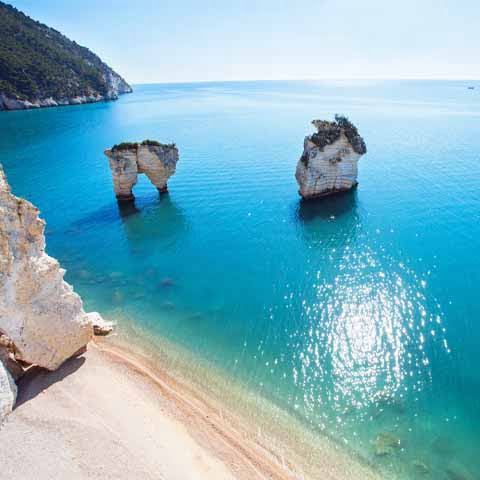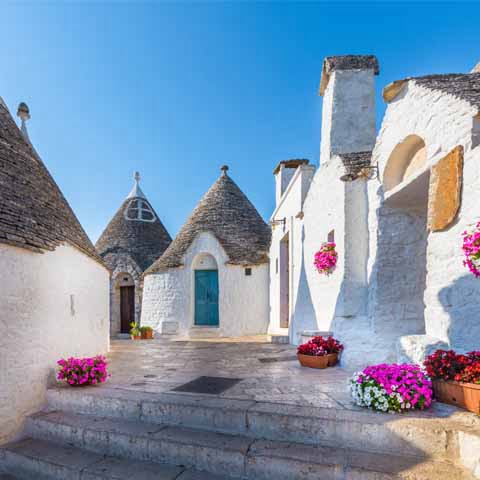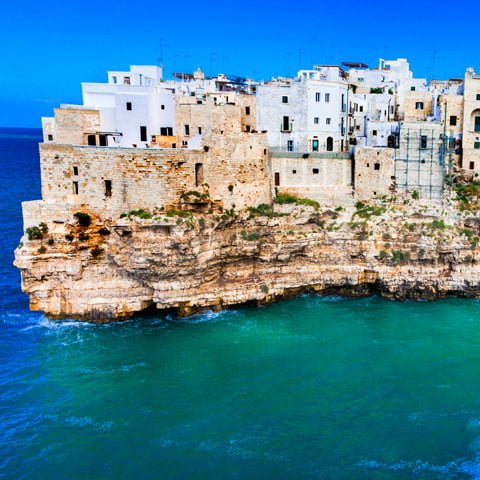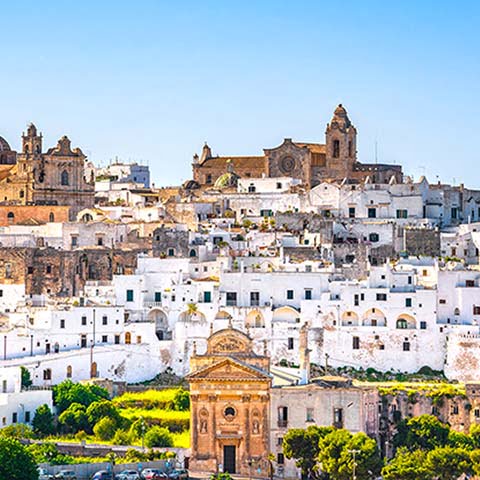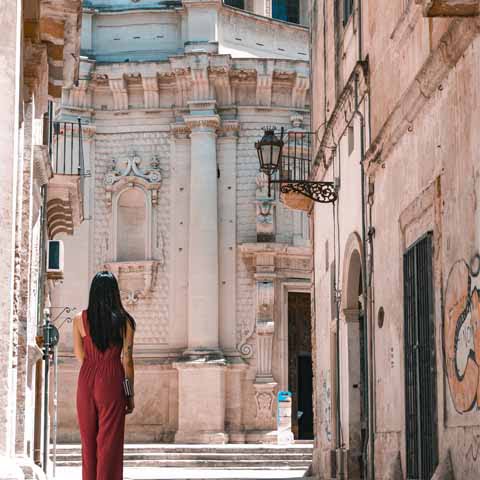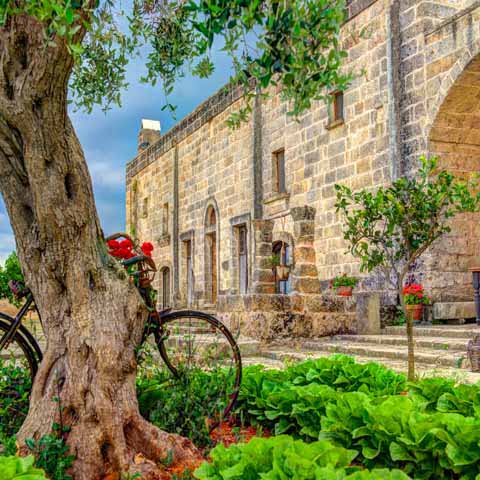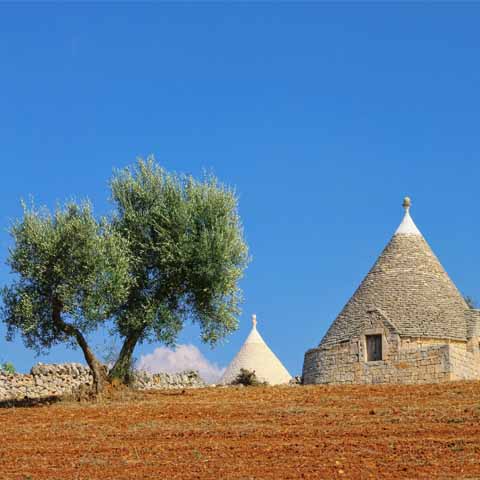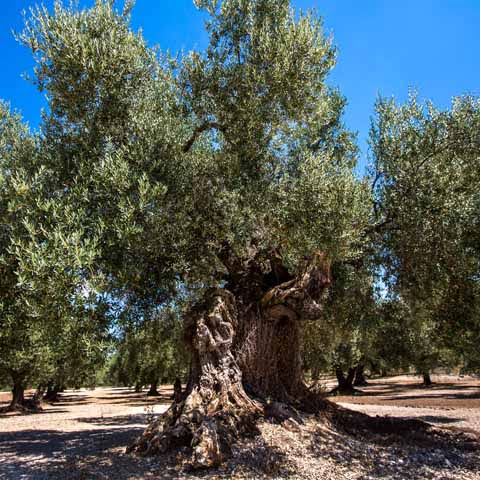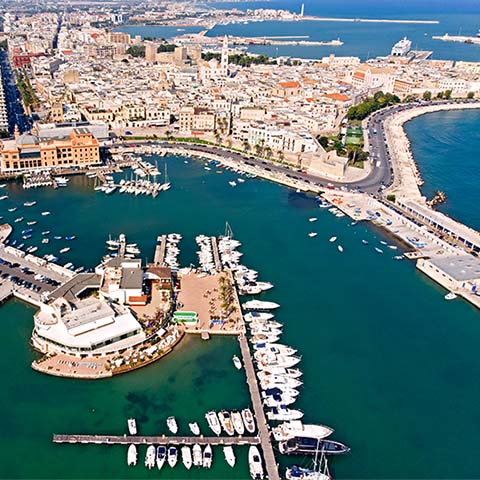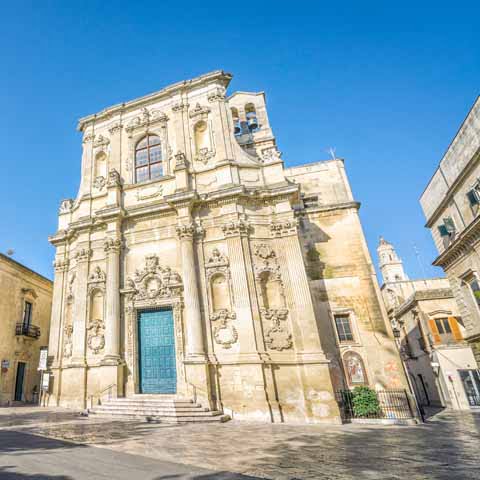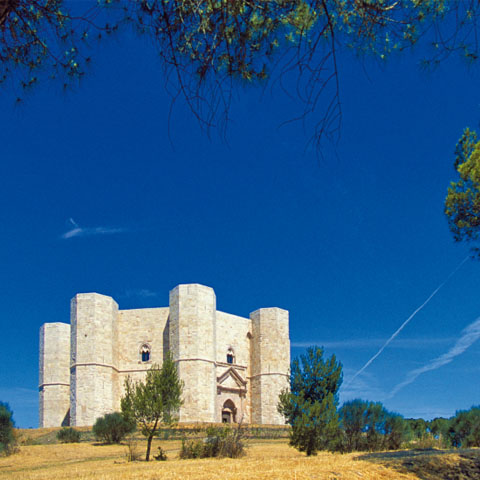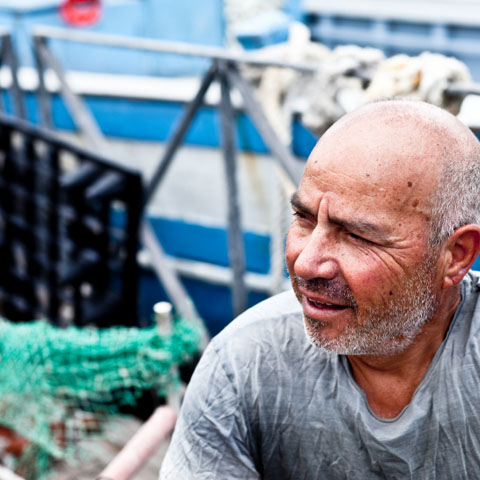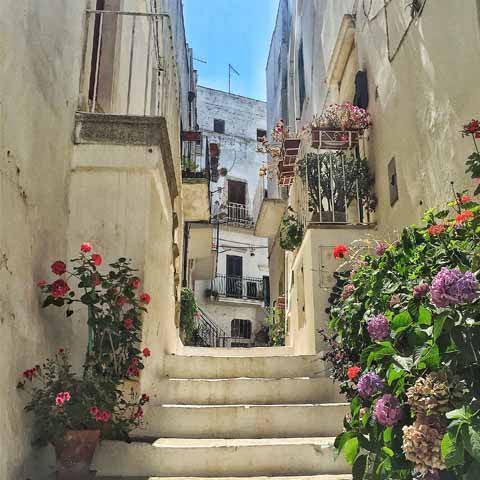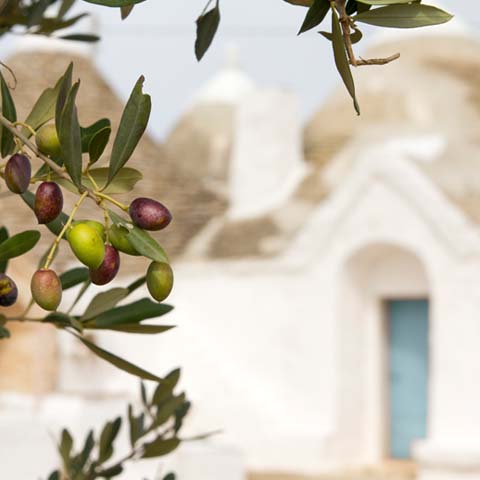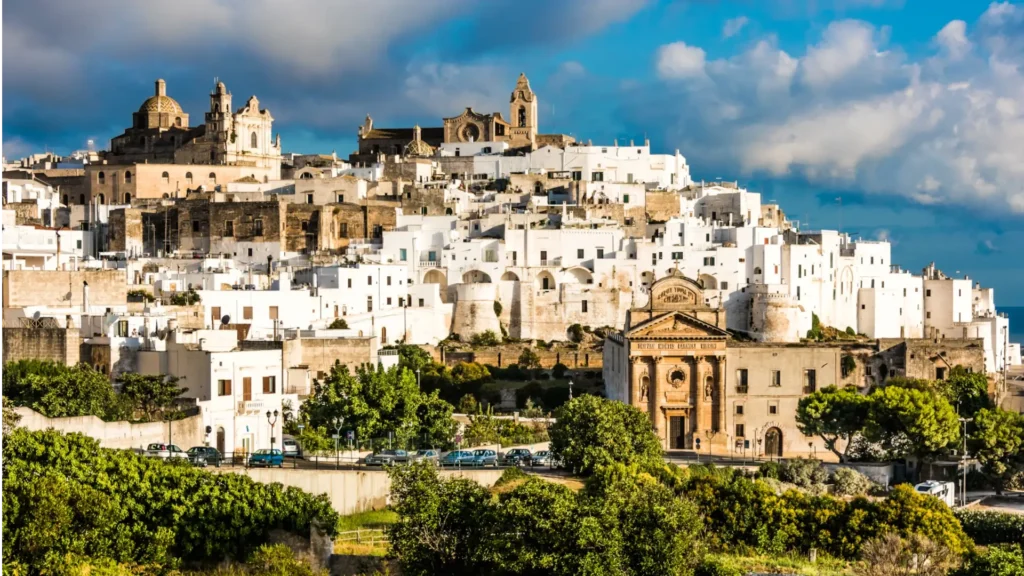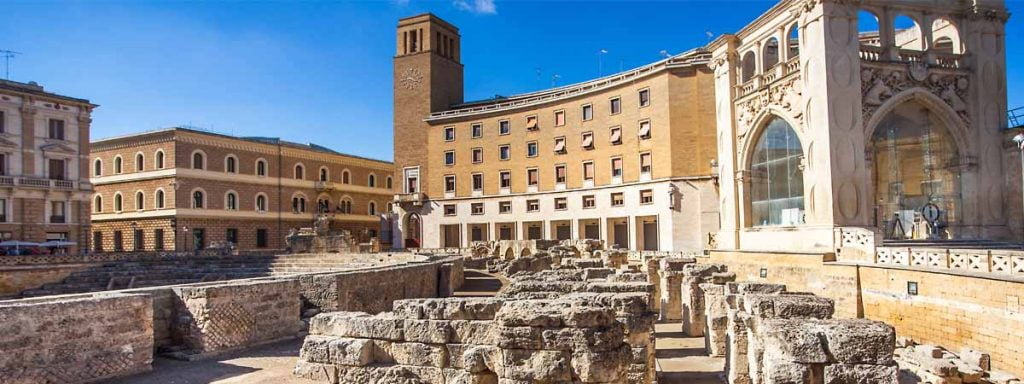Apulia – Ultimate Travel Guide
Nominated by National Geographic as one of the most beautiful places in the world, Apulia is a region almost completely surrounded by the sea. The marine environment represents one of the region’s main attractions. From white sand beaches to those covered in pebbles, Apulia has something to offer everyone when on a trip to Italy.
Apart from the sea, Apulia also has splendid mountains, rolling hills, and expansive plains. In fact, the region has many landscapes that blend in charming contrasts.
Defining Apulia is not an easy task. From uncontaminated nature to amazing history, secular traditions, delicious food and strong devotion to religion, the heel of the Italian Boot is simply enchanting.
This beautiful land stretches along the Adriatic coastline and is home to marvelous beaches and bays. Choose between the crystalline waters of the Ionian Sea or the intense blue Adriatic, between Salento or Gargano, or between bustling resorts or quiet hidden villages.
If the seaside is the draw during the hot summer months, in spring and autumn Apulia impresses with its nature. Gargano’s wild Umbra Forest is one of the most popular destinations, although Alta Murgia National Park is equally attractive.
From a cultural point of view, Apulia is unique. The bonds the region has with foreign cultures are strongly visible in all the corners of this land. From an artistic and architectural point of view, Lecce impresses with its unique Baroque buildings and with glimpses from the Renaissance times.
While in the Valle d’Itria, trulli are a living example of the complex cultural heritage of the region. The numerous castles and churches also represent the spirit of Apulia.
Apulia is a land of contrasts, and the same is true when it comes to food. In the seaside areas, exquisite fish and seafood dishes abound, while the inland offers delicious cheeses, various game, and a wide variety of other mouth-watering foods.
Geography and Climate of Apulia
Although it is made up of various areas that are completely different, Apulia is a region with well-defined characteristics that maintain a precise unity, conferred by a lithological and structural consistency. In fact, Apulia’s territory is characterized by plains and karst plateaus, which rarely assume mountainous features even at the highest altitudes. This unique profile is given by the large diffusion of limestone arranged in horizontal and sub-horizontal layers. As such, the landscape has a somehow tabular appearance with an extremely poor hydrographic structure on the surface, which corresponds to a considerable development of the karst phenomena.
From north to south, Apulia is divided into four geographical areas, Gargano, Tavoliere, Murge, and Salento. Furthermore, do not miss the Daunia Mountains, a band of the Apennines that rises to 3,779 feet in the west, as well as the coastal stretch of land that encloses the Taranto area.
The Gargano sub-region is predominantly made of limestone cliffs and is characterized by a compact, wavy surface and steep, or terraced slopes. Gargano also boasts two coastal lakes, Lesina and Varano, and a protected oasis near Manfredonia, Oasi Lago Salso, which is protected by the World Wildlife Fund.
Tavoliere is an area of plains, characterized by extensive pastures that overlook the Adriatic Sea south of Gargano and over the Gulf of Manfredonia. The shallow, sandy coastal dunes constitute a serious obstacle to the outflow of the few rivers that cross the region.
Moving south, we have the sub-region known as Murge, also characterized by a limestone relief that slopes gently towards the Adriatic Sea. Meanwhile, Salento’s relief is similar to that of the Murge and it is characterized by the same horizontal profiles and the almost total lack of surface watercourses.
Apulia’s coast is predominantly low, sandy, and fairly straight between Brindisi and Manfredonia. Things change in the Gargano area, where the coast is high, rocky, and sprinkled with numerous coves, beaches, and bays.
A true pearl of Apulia is the archipelago known as the Tremiti Islands, territorially belonging to Gargano. This splendid archipelago consists of five islands of which San Domino is the largest, and it is located about 12 miles from the northern coast of the mainland.
The climate of the region is Mediterranean and can vary widely between the coastal and mountain areas. Nevertheless, winters are generally mild while the summers are usually hot. In fact, Salento often feels the influence of the hot African winds, while the highest areas of Gargano and Daunia are characterized by a cooler and more refreshing atmosphere.
Rainfall is mostly concentrated in the winter months, yet generally speaking it is rather scarce.
What to Do in Apulia
Apulia is a region with plenty of activities all year long. While the beaches and bays draw people during the summer for sunning, swimming, snorkeling and diving, hikers and cyclists abound in the spring and fall.
The region also features numerous cathedrals, museums and historic sites to explore. This is an ideal way to discover the fascinating history and influences of the area.
Taste the Local Food and Wine
Like in all regions of Italy, food in Apulia is considered an important part of the culture. The culinary traditions of the region have been shaped by the many civilizations that passed through this land over the centuries, but also by the fresh products and simple yet tasty recipes. Since the cuisine is a big part of the history of the region, this is the perfect opportunity for food enthusiasts to take a cooking class while exploring Apulia.
Apulia’s cuisine is primarily based on the use of seasonal vegetables, legumes and many kinds of aromatic herbs, all seasoned with abundant, locally-produced extra virgin olive oil.
Among the exquisite dishes to taste, N‘capriata, also known as fave e cicoria, stands out. This dish from Brindisi is prepared with mashed beans, chicory, and olive oil.
Pancotto, a staple of Italy’s simple culinary techniques, is a soup made from stale bread and leftover vegetables that can be found throughout the country with multiple local variations in Puglia as well. Ingredients and preparation techniques can vary even within the same province. In Foggia, this dish is called pancotto foggiano, and it features stale bread, wild arugula (or at times chicory), and plenty of olive oil.
Rustici, consisting of puff pastry stuffed with various vegetables, cheeses and meat, are another popular dish in the region, particularly in Lecce and the rest of the Salento area.
When it comes to pasta, orecchiette is the most characteristic shape of the region and Puglia’s traditional pasta dish is orecchiette alle cime di rapa (orecchiette with broccoli rabe), though orecchiette can be served with countless types of sauces throughout the region.
In a land where hectares of fields are cultivated with wheat, bread plays an important role, but the art of baking is taken well beyond the making of bread. Taralli are probably the most beloved snack in Puglia and these rustic, ring-shaped crackers can be seasoned with salt, fennel seeds and/or black pepper.
The relatively few meat dishes contrast with the remarkable variety of seafood specialties. Anchovies and mussels are symbols of the region, and so is the tarantello di tonno, slices of tuna from the lower abdominal area that are preserved in extra virgin olive oil.
Cheeses are also exquisite in the region, made with the milk from either cow or sheep. A complete cheese platter in Apulia should contain burrata and mozzarella, caciocavallo, ricotta, pecorino, scamorza and provola cheese.
When it comes to the wines, Apulia is the first region in Italy regarding both cultivated surface area and wine production. Among the local types of wine, worth mentioning are Moscato di Trani and Rosso di Cerignola, to name just a couple.
Cycling in Apulia
Discovering Apulia while riding a bike among ancient seaside villages, rural landscapes, cities of art, and natural parks is an unforgettable experience. In fact, the slow pace of cycling allows for intimate discovery of the numerous nuances of this region, its scents, and its beauty.
There are literally more than dozens of paths to follow, either along the coastline or among the marvels of the inland. In Murgia, for example, you can cycle along rural trails up to Castel del Monte, a designated UNESCO site since 1996 with a distinct shape.
History enthusiasts can cycle along Via Traiana, an Ancient Roman road, to discover the Archaeological Park of Egnazia near Fasano. A little further south, hidden between olive groves is the regional park Parco delle Dune Costiere, a unique area that is enchanting with its natural beauty and known for its beachfront dunes.
Via dei Castelli, in Salento, is another amazing cycling route that allows for discovery of the ancient flavors of the area. Via del Mare, also a favorite route for cycling, spans to Otranto and Punta Palascia, the easternmost point of Italy.
The Itria Valley is among the most peculiar areas in Apulia and is rich in traditions. Discovering it by bike is extremely interesting and fulfilling. A ride here winds through an area that boasts unique natural and architectural marvels, among which the most impressive are the Trulli, which are white, conical-shaped huts, and the expansive olive trees. A few towns to discover along the way are Alberobello, Cisternino and Locorotondo.
Ciclovia dell’acquedotto Pugliese is a famous hiking and cycling route of about 310 miles that stretches along two historic aqueducts. The route crosses three regions, Apulia, Campania and Basilicata, connecting some of the most interesting sites of all three areas.
The province of Foggia is another part of Apulia that can be explored by bike. This province holds some of the main attractions of the region, including the Dauni Mountains and the National Park of Gargano, which boasts an amazing coastline and stunning forests.
A great route in the region starts at the Adventure Park Pila Sant’Onofrio in Pietramontecorvino and ends in Biccari, at Adventure Park Lago Pescara. Both adventure parks represent a true attraction for grownups and children alike, while the beauty of the Dauni Mountains will certainly impress.
Salento is a famous summer destination, yet this territory is also noteworthy during fall or spring. The best way to explore this territory by bike is riding between picturesque villages along the breathtaking coastline, especially between Otranto and Santa Maria di Leuca.
If you want to admire most of Apulia’s marvels by bike, maybe the best thing to do is to ride along Ciclovia Adriatica, a cycling route that spans from Santa Maria di Leuca all the way to Trieste, in Friuli Venezia Giulia, a northern region of Italy. In Apulia alone, the route counts over 310 miles and passes through a variety of landscapes that offer valuable insight into the peculiarities and uniqueness of this region.
Sunbathing and Diving in Apulia
Apulia is a land of the sea, and its amazing coastlines inspire both passionate divers and those who’d rather catch some rays on a beach.
Diving and snorkeling enthusiasts will be happy to hear that Apulia is rich in diving spots characterized by crystal-clear waters and numerous underwater treasures. Both the Adriatic and the Ionian seas host uncontaminated nature, colorful vegetation, amazing games of light, caves, creeks, and unimaginable marine species.
The region not only boasts breathtaking places, it is also perfectly equipped to welcome the lovers of these sports. Most coastal areas have shops that sell or rent all necessary diving equipment, while many beaches have specialized diving centers where you can find guides, course instructors, and information about the best diving and snorkeling spots.
Among the many places where one can dive in Apulia, we can mention Punta Meliso, located close to the lighthouse of Santa Maria di Leuca. This is the spot where the two seas that bathe Apulia, the Adriatic, and the Ionian, meet, and diving here offers a truly unique experience.
The area is rich in various species of fish and marine fauna, the water is crystalline and the spot is accessible to everyone, regardless of experience level. The depth of the seabed varies between 20 and 60 feet, while the quiet bay shelters the area from the strong currents.
Another diving spot accessible to both inexperienced and professional divers is Soffio Cave. This spot is also protected from currents and strong streams, and the maximum diving depth is approximately 40 feet. The cave owes its name to the sound of the water that is generated by the waves, which sounds like a puff of air (soffio in Italian). The wide entrance of the cave allows sunlight to pass through and create fabulous light effects on the cave walls while the seabed is full of shrimp and other forms of marine life.
Santa Caterina, a small district of Nardò in the province of Lecce, is another place to go for diving. The most popular diving spot in this area is the cave of Santa Caterina called II Curvone. The cave is twenty feet long and the depth of the seabed is about 23 feet, characteristics that make it ideal for both newbies and experienced divers alike.
The fauna is rather unique, and inside the cave, you will be able to admire an impressive variety of sponges and other forms of life. For this reason, this is a favorite among those who have a passion for underwater photography. The most experienced divers can choose to follow the wall of the cave and dive to a depth of up to 65 feet; this place is also suitable for night diving.
Secca delle Murene, in Porto Cesareo, is another unique diving spot to discover. The peculiarity of this place is given by the seabed which is completely covered in algae, not to mention the attractive, colorful marine life.
There are countless options available in this region, but hands down the place to go if you want to live an ultimate diving experience are the Tremiti Islands. Belonging to Gargano area, the Tremiti Islands boast over 50 diving spots. One of the most renowned is Punta Secca, located on the tranquil Capraia Island and regarded as one of the best places to dive and snorkel in Apulia. The underwater bursts an explosion of color and life while the seabed is 115 feet deep. Another spot that is also suitable for beginners is the Elephant Rock, which is located on San Domino Island and is famous for its unique shape.
There are dozens of beaches that can cater to those that like to lounge on the sand and relax to the sound of the surf. Among them, the best to visit are Pizzomunno beach in Vieste del Gargano, a beach famous for its peculiar limestone sea stack. Baia delle Zagare in Mattinata and Pugnochiuso between Mattinata and Vieste are two other beaches of Gargano that impress with their beauty.
Salento, on the other hand, is a famous destination for the young and restless. Here, the beaches are characterized by white sand and the impression is that of being in another part of the world, such as the Caribbean. Some of the most popular beaches of the area are Torre dell’Orso and Porto Badisco.
Cala dell’Acquaviva is another spectacular beach in Salento where you can live the unique experience of visiting a fjord in flip flops and swimming suit. The water is almost always cool, and the scenery is absolutely amazing.
Lastly, a marvelous place to discover if you love both sunbathing and diving is Porto Selvaggio, between Gallipoli and Porto Cesareo. This natural reserve boasts splendid waters, beaches, and the Horse Cave, the place where the oldest remains of Homo Sapiens in Europe were discovered.
